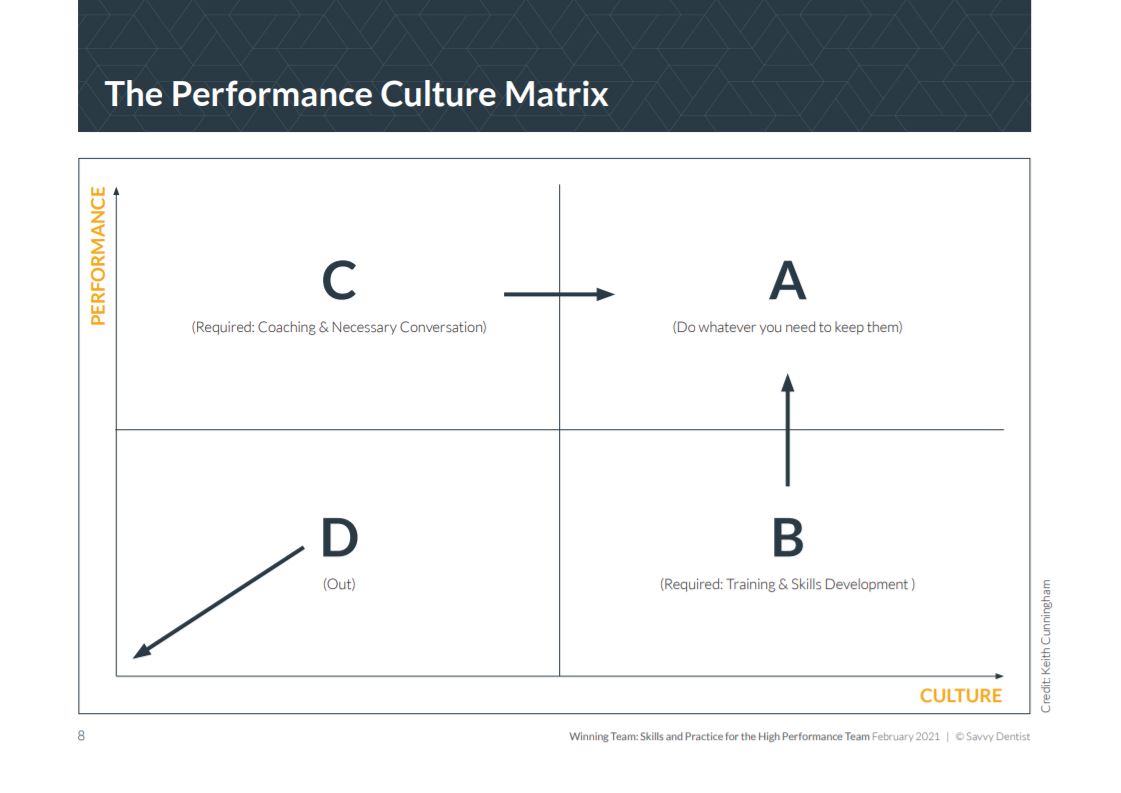I am yet to meet the person who comes to work knowingly, willingly, trying to do a poor job. Most people are internally wired to want to do their job successfully, and want to do it well.
However, sometimes there can be problems that occur when we have a disconnect between what we believe is a good job, and what our team are delivering. They think they’re doing a great job, but it may not meet our expectations.
In many cases, this is the fault of the practice owner who needs to consider whether the issue lies in the talent they have recruited, or the way they communicate expectations to team members.
The performance-culture matrix is a powerful diagnostic tool when it comes to determining the suitability of a team member. It allows practice owners to very simply categorise team members, identify areas for growth, and take the necessary action to either align talent or, in some cases, decide to move them along.
The Performance-Culture Matrix
The first axis is culture, where you determine whether or not your team member in question is an exact cultural fit. The second access is performance, where you assess their effectiveness within their role. I’d urge you to be quite cut-throat in your evaluation, just to save any wishy-washy indecision.
As you can see, there are four resulting categories.
A-Player
An A-Player is a great culture fit, great performer. Your only objective here is to continue to nurture great alignment, and retain them. If you’ve got a handful of A-Players, you’re doing pretty well!
B-Player
A B-Player, on the other hand, is someone who is actually a great culture fit, however they’ve got some skills to develop. This is still a pretty good spot to be in, because they can be trained in-house.
For example, you might have a dental assistant who is amazing as a dental assistant, great culture fit, really proficient in their role, but you need them to move up into a reception role. Because they have the same values and vision, all you need is to close the skills gap in order to bring them up to A-Player status.
C-Players
C-Players are the ones that give practice owners headaches and grey hair. They’re typically very good at their jobs, often popular among the team and with patients, but just don’t quite click with company culture.
We struggle to let them go because they are so competent and we don’t want to lose the skill set or the relationship with patients etc. But in that situation, we tend to accommodate, adapt, and accept. We tolerate things we normally wouldn’t and end up lowering standards.
So, with C-Players, your goal is to try and get them on board culturally, and that’s not as easy as it sounds. It means having some difficult conversations, sticking to your guns, and if it’s not a good fit, they will often drop to the next level.
D-Players
Frankly, we need to liberate D-Players so they can go find other opportunities. Within a self-managing team, there is no room for D-Players who are neither culturally aligned nor effective in their roles. It doesn’t mean they’re a terrible person or anything, it just means that it didn’t work out this time, and you are one step closer to a team of A-Players.
P.S Want to scale your dental practice and take your profits to 7 figure success?
Me and my team can work with you directly to get you there! Simply book in your FREE 1:1
strategy session, and we can get started on a game plan for you and your practice.




